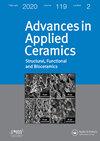Cold spray for ceramic metallisation: a review
IF 1.6
4区 材料科学
Q3 MATERIALS SCIENCE, CERAMICS
引用次数: 0
Abstract
ABSTRACT Since invented in 1980s, cold spraying (CS) has received numerous attentions recently because of its low heat input and high efficiency. Severe plastic deformation induced by high-velocity impaction makes the particles with temperature below the melting point deposited on the substrate. Theoretically, the coating obtained by CS is dense and free of oxidation, so excellent thermal and electrical conductivity can be obtained, which is ideal for ceramic metallisation (CM). Many studies have been done on the CS CM to study the coating structures, bonding mechanism and performances. Mechanical occlusion is considered to be the main bonding type at the interface, local melting plays a small role in the bonding, but local melting improves the bonding strength significantly. However, the specific bonding mechanism of CS CM is still unclear, especially in some metal/ceramic systems with bonding strength greater than 10 MPa, the bonding mechanisms need to be further studied. CS is also difficult to metallise some ceramics, which requires complicated design. Thus, aiming to improve the reliability and the extent of the application of CS CM, a thorough review should be made. In the present paper, the bonding mechanisms of CS metal coating on ceramic proposed by previous researches were summarised to help the researchers a better and quicker understanding for the CS CM. The factors influencing the properties were introduced. The author also made an outlook for the future development of CS in CM.陶瓷金属化冷喷涂技术综述
自20世纪80年代发明以来,冷喷涂技术因其低热量输入和高效率而受到广泛关注。高速撞击引起的剧烈塑性变形使温度低于熔点的颗粒沉积在基体上。理论上,CS获得的涂层致密且无氧化,因此可以获得优异的导热性和导电性,是陶瓷金属化(CM)的理想选择。人们对CS - CM涂层的结构、结合机理和性能进行了大量的研究。机械咬合被认为是界面的主要结合方式,局部熔化对结合作用较小,但局部熔化显著提高了结合强度。然而,CS CM的具体键合机制尚不清楚,特别是在一些键合强度大于10 MPa的金属/陶瓷体系中,其键合机制有待进一步研究。CS也很难将一些陶瓷金属化,这需要复杂的设计。因此,为了提高CS CM的可靠性和应用范围,应该对CS CM进行全面的审查。本文对前人提出的CS金属涂层在陶瓷上的结合机理进行了综述,以帮助研究人员更好、更快地理解CS金属涂层。介绍了影响其性能的因素。作者还对CS在CM中的未来发展进行了展望。
本文章由计算机程序翻译,如有差异,请以英文原文为准。
求助全文
约1分钟内获得全文
求助全文
来源期刊

Advances in Applied Ceramics
工程技术-材料科学:硅酸盐
CiteScore
4.40
自引率
4.50%
发文量
17
审稿时长
5.2 months
期刊介绍:
Advances in Applied Ceramics: Structural, Functional and Bioceramics provides international coverage of high-quality research on functional ceramics, engineering ceramics and bioceramics.
 求助内容:
求助内容: 应助结果提醒方式:
应助结果提醒方式:


